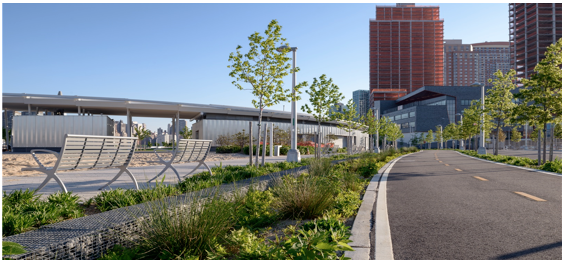CommentsLA MATTERS--Water is our most precious resource — and, as the 2016 World Economic Forum Global Risks Report makes clear, water crises, failure of climate adaptation and loss of ecosystem services are major concerns to our global society. To take advantage of water’s benefits while minimizing its risks, city governments need to recreate a naturally-oriented water cycle while contributing to the amenity of the city by bringing water management and green infrastructure together – an idea known as Blue-Green Cities.
Luckily, this message is increasingly being heeded. To push the agenda forward among LA’s government officials, the general public, and design and building professionals, the U.S. Green Building Council’s Los Angeles chapter has made urban water resilience the theme of its upcoming conference. Resilience is, very basically, a practice that prepares communities to respond to and bounce back from both disasters and on-going stressors that create vulnerabilities in our communities.
Looking back
But to look forward, it’s important that we first look back. Urban water infrastructure has come a long way over the years. In the late 19th century, Sir Joseph Bazalgette led the construction of a city-scale sewer system for London — the world’s first. This came about in the wake of cholera outbreaks linked to unsanitary water wells. The phenomenal feat of retrofitting a city for improved public health became a global benchmark.
Another important example rests closer to home. Historically, the Los Angeles River was a beautiful and complex ecological system flowing through marshes, forests, swamps, and wetlands. Today, it’s a 51-mile engineered channel, gradually built in concrete between 1938 to 1960 as floodwater threatened the city.
New challenges
Both of these examples demonstrate humankind’s ingenuity in the face of major public health and safety issues. Of course, we’re in a new era today. With increased urbanization and climate change threatening our way of life, we need a paradigm shift in how we plan and engineer our cities for the future.
A recent report by the Natural Resources Defense Council notes that 4 billion people worldwide are affected by water scarcity every year. According to the journal Nature Climate Change, 13.1 million people living along the U.S. coast are threatened by sea level rise by the end of this century.
Demographic trends will only exaggerate these challenges: by 2050, eight out of every ten people will live in an urban area.
Blue-Green Cities
City governments are increasingly aware of these risks and are responding by implementing initiatives that support the transformation to Blue-Green Cities. But is this happening fast enough to keep future citizens safe? This is debatable.
What’s not debatable is that we can do more. Some outstanding examples demonstrate how cities can implement city-scale blue and green infrastructure to incorporate sustainability and increase resilience.
- After conducting research, rolling out demonstration projects, and involving multiple agencies, the New York City Department of Environmental Protection is investing $2.4 billion on new green infrastructure in the next 20 years.
- London’s new Olympic Park was designed to serve its city for far longer than the duration of the 2012 Summer Olympics. Today, it brings biodiversity back into the city and integrates climate change protection —the open space has helped to absorb floodwater nine times since its opening.
- The Cheonggyecheon stream restoration project in the heart of Seoul removed an elevated highway to create a river through the city. The end result can accommodate a 200-year flood in addition to reducing air pollution by 35%, attracting 64,000 visitors per day, and increasing nearby property value by 30 to 50%.
A 21st-century urban river
And how about Los Angeles? The City of LA and many groups and companies across the region are in the throes of rethinking the city’s water infrastructure—from groundwater storage to parks. But the main artery of our city has rightfully drawn some of the strongest attention. Since 2007, the LA River Revitalization Master Plan has been driving significant and positive change. This plan provides an opportunity to harness community activism and create a step change that will allow the river to transform from a single-function piece of infrastructure to a multifaceted community asset. As is the case in other urban water initiatives, realizing this goal will require strong political leadership, careful planning, and creative engineering.
(Vincent Lee, PE, LEED AP, ENV SP is an Associate Principal in Arup with over 17 years of experience in sustainable site development, green infrastructure and integrated water resource management. His engineering background has enabled him to implement water-resilient cities and communities across the world.) Photo Credit: "Charles Aydlett". Photo is one of Arup's projects in NYC, called Hunter's Point South.
-cw
















